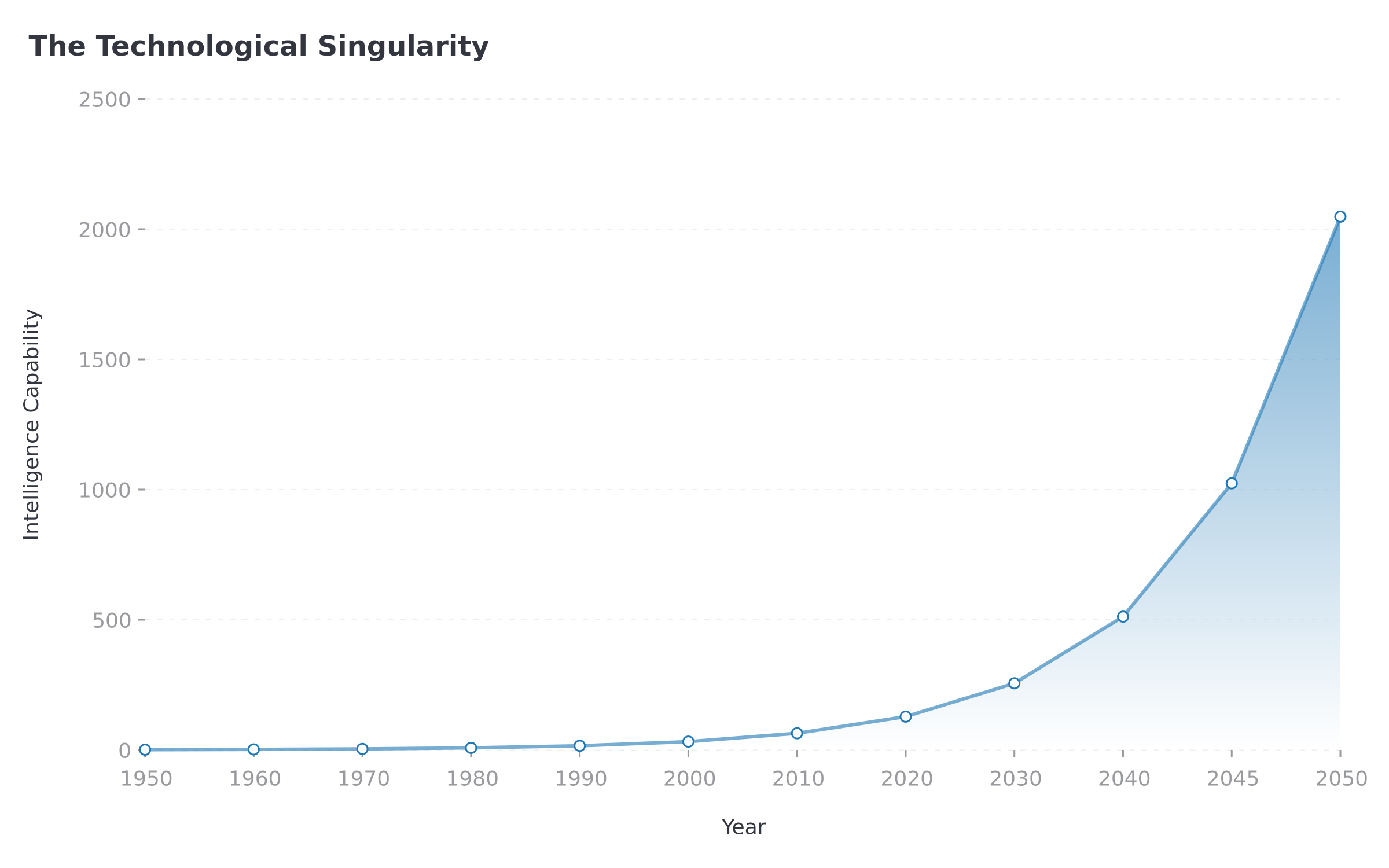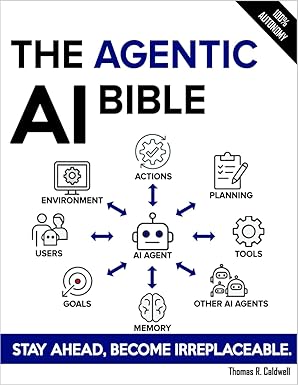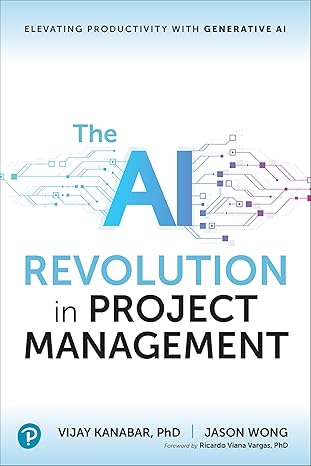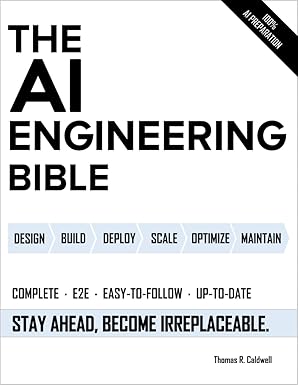Approaching the Singularity: Myth, Metrics, & What Comes After

Ad Space
Approaching the Singularity: Myth, Metrics, & What Comes After
The Technological Singularity—a hypothetical point where artificial intelligence becomes capable of recursive self-improvement, leading to rapid technological growth beyond human comprehension—has captured imaginations and sparked debates for decades. But what exactly is the Singularity, how close are we to it, and what metrics might signal its approach? Let's examine this concept through the lens of its originators, current technological progress, and measurable indicators.
Origins and Evolution of the Concept
Vernor Vinge: The Mathematical Foundation
The Original Vision (1993) Mathematician and science fiction author Vernor Vinge first popularized the term "Technological Singularity" in his seminal essay "The Coming Technological Singularity."
Key Insights:
- Mathematical Analogy: Named after gravitational singularities in physics—points where mathematical models break down
- Intelligence Explosion: Once machines become better at creating intelligence than humans, they will rapidly improve themselves
- Prediction Horizon: Beyond the Singularity, technological progress becomes unpredictable
- Timeline: Originally predicted within 30 years (by 2023)
Vinge's Four Paths to Singularity:
- Artificial Intelligence: Computers that are "awake" and superhumanly intelligent
- Intelligence Amplification: Human-computer interfaces that enhance human intelligence
- Biological Enhancement: Genetic engineering or other biological improvements to human intelligence
- Network Intelligence: Large computer networks that "wake up" as superhumanly intelligent entities
Current Assessment: Vinge's timeline was optimistic, but his conceptual framework remains influential in AI research and futurism.
Ray Kurzweil: The Exponential Prophet
The Law of Accelerating Returns (2005) Inventor and futurist Ray Kurzweil expanded on Vinge's concept with detailed predictions and mathematical models.
Core Principles:
- Exponential Growth: Technological progress follows exponential rather than linear patterns
- Convergence: Multiple technologies (AI, nanotechnology, biotechnology) will converge
- Timeline: Predicted Singularity by 2045
- Post-Singularity: Human and artificial intelligence will merge
Kurzweil's Predictions for the Path to Singularity:
- 2020s: AI reaches human-level intelligence in specific domains
- 2030s: AI achieves human-level general intelligence
- 2040s: AI surpasses human intelligence, leading to Singularity
- 2050s+: Post-human civilization emerges
Track Record: Kurzweil's predictions have been mixed—some remarkably accurate (internet adoption, mobile computing), others overly optimistic (AI timelines, nanotechnology).
Academic and Research Perspectives
I.J. Good's Intelligence Explosion (1965) Mathematician I.J. Good actually preceded both Vinge and Kurzweil with the concept of an "intelligence explosion":
"Let an ultraintelligent machine be defined as a machine that can far surpass all the intellectual activities of any man however clever. Since the design of machines is one of these intellectual activities, an ultraintelligent machine could design even better machines; there would then unquestionably be an 'intelligence explosion,' and the intelligence of man would be left far behind."
Modern Academic Views:
- Nick Bostrom (Oxford): Focuses on superintelligence and existential risk
- Stuart Russell (UC Berkeley): Emphasizes AI safety and control problems
- Eliezer Yudkowsky (MIRI): Advocates for AI alignment research before Singularity
- Robin Hanson (GMU): Skeptical of rapid takeoff scenarios, predicts gradual economic transformation
Key Inflection Points: What to Watch For
1. Recursive Self-Improvement
Definition: AI systems that can modify and improve their own code, architecture, or training procedures.
Current State:
- Limited Examples: Neural Architecture Search (NAS), AutoML systems
- Human Oversight: Current systems require human guidance and validation
- Narrow Domains: Self-improvement limited to specific tasks or architectures
Progression Indicators:
Level 1: Automated Hyperparameter Optimization
- Current Status: ✅ Achieved
- Examples: Automated tuning of learning rates, batch sizes, model architectures
- Significance: Foundational capability for more advanced self-improvement
Level 2: Architecture Self-Design
- Current Status: 🔄 In Progress
- Examples: Neural Architecture Search, automated model compression
- Timeline: 2025-2027
- Significance: AI systems designing their own neural network structures
Level 3: Training Procedure Self-Modification
- Current Status: 🔄 Early Research
- Examples: AI systems modifying their own training algorithms
- Timeline: 2026-2029
- Significance: Systems that can improve how they learn
Level 4: Goal and Objective Self-Modification
- Current Status: ❌ Not Achieved
- Examples: AI systems modifying their own reward functions or objectives
- Timeline: 2028-2032
- Significance: Potentially dangerous without proper alignment
Level 5: Full Recursive Self-Improvement
- Current Status: ❌ Not Achieved
- Examples: AI systems improving all aspects of their intelligence autonomously
- Timeline: 2030-2040
- Significance: Potential trigger for intelligence explosion
Warning Signs to Monitor:
- AI systems making unexpected improvements to their own performance
- Rapid capability gains that exceed human understanding
- AI systems requesting or demanding more computational resources
- Emergence of novel problem-solving approaches not programmed by humans
2. AI-Driven Scientific Discovery
Definition: AI systems that can formulate hypotheses, design experiments, and make scientific discoveries autonomously.
Current Capabilities:
- Protein Folding: AlphaFold revolutionized structural biology
- Drug Discovery: AI systems identifying promising pharmaceutical compounds
- Materials Science: AI discovering new materials with desired properties
- Mathematics: AI systems proving theorems and discovering new mathematical relationships
Progression Indicators:
Level 1: Accelerated Analysis
- Current Status: ✅ Achieved
- Examples: AI analyzing large datasets, identifying patterns
- Impact: Speeds up existing research processes
Level 2: Hypothesis Generation
- Current Status: 🔄 In Progress
- Examples: AI systems proposing new research directions
- Timeline: 2025-2027
- Impact: AI becomes a research partner
Level 3: Autonomous Experimentation
- Current Status: 🔄 Early Stages
- Examples: AI-controlled laboratories, robotic scientists
- Timeline: 2026-2029
- Impact: AI conducts research independently
Level 4: Paradigm-Shifting Discoveries
- Current Status: ❌ Not Achieved
- Examples: AI discovering fundamental new physics or mathematics
- Timeline: 2028-2035
- Impact: AI surpasses human scientific intuition
Level 5: Self-Directed Research Programs
- Current Status: ❌ Not Achieved
- Examples: AI systems setting their own research agendas
- Timeline: 2030-2040
- Impact: AI becomes the primary driver of scientific progress
Breakthrough Indicators:
- AI systems making Nobel Prize-worthy discoveries
- Fundamental advances in physics, mathematics, or computer science by AI
- AI systems developing new scientific methodologies
- Acceleration of scientific progress beyond human capacity to follow
3. Economic and Technological Convergence
Definition: The merging of AI with other exponential technologies (nanotechnology, biotechnology, quantum computing) creating synergistic effects.
Current Convergence Areas:
AI + Biotechnology:
- Examples: AI-designed proteins, personalized medicine, genetic engineering
- Progress: Rapid advancement in drug discovery and genomics
- Timeline: Major breakthroughs expected 2025-2030
AI + Nanotechnology:
- Examples: AI-designed materials, molecular manufacturing
- Progress: Early stages, significant technical challenges remain
- Timeline: Practical applications 2030-2040
AI + Quantum Computing:
- Examples: Quantum machine learning, AI-optimized quantum algorithms
- Progress: Theoretical work advanced, practical applications limited
- Timeline: Significant impact 2028-2035
AI + Robotics:
- Examples: General-purpose robots, autonomous manufacturing
- Progress: Rapid advancement in dexterity and intelligence
- Timeline: Widespread deployment 2025-2030
Convergence Indicators:
- AI systems designing other AI systems
- Automated research and development across multiple fields
- Self-replicating or self-improving technological systems
- Economic growth rates that exceed historical patterns
Real-World Metrics: Measuring Progress Toward Singularity
Computational Metrics
1. Compute Growth Rate
- Current Trend: AI training compute doubling every 6 months (2012-2018), now slowing to ~10 months
- Singularity Indicator: Return to 6-month doubling or faster
- Threshold: When AI systems can improve their own efficiency faster than hardware advances
2. Algorithmic Efficiency
- Current Trend: ~44x improvement in ImageNet efficiency since 2012
- Measurement: Performance per unit of compute
- Singularity Indicator: AI systems achieving >1000x efficiency improvements through self-modification
3. Model Size and Capability Scaling
- Current Trend: Largest models growing from millions to trillions of parameters
- Measurement: Parameters, training data size, emergent capabilities
- Singularity Indicator: Capability improvements that exceed scaling law predictions
Economic Metrics
1. AI-Driven Productivity Growth
- Current State: Modest productivity gains from AI adoption
- Measurement: GDP per capita growth, total factor productivity
- Singularity Indicator: Sustained >5% annual productivity growth driven by AI
2. Research and Development Acceleration
- Current State: AI speeding up specific research areas
- Measurement: Time from discovery to application, patent filing rates
- Singularity Indicator: R&D cycles shortened by >10x across multiple fields
3. Economic Disruption Rate
- Current State: Gradual automation of specific job categories
- Measurement: Job displacement rate, new industry creation
- Singularity Indicator: >50% of jobs transformed within a 5-year period
Scientific and Technological Metrics
1. Scientific Discovery Rate
- Current State: AI contributing to discoveries in specific domains
- Measurement: AI-authored papers, breakthrough discoveries per year
- Singularity Indicator: AI making majority of significant scientific discoveries
2. Patent and Innovation Metrics
- Current State: Increasing AI-assisted patent applications
- Measurement: AI-generated patents, innovation cycle times
- Singularity Indicator: AI systems filing patents for fundamental breakthroughs
3. Cross-Domain Knowledge Transfer
- Current State: Limited transfer between AI domains
- Measurement: Performance on diverse benchmarks, few-shot learning capability
- Singularity Indicator: AI systems achieving human-level performance across all cognitive domains
Social and Behavioral Metrics
1. Human-AI Collaboration Patterns
- Current State: AI as tool, human as decision-maker
- Measurement: Decision-making authority, human oversight requirements
- Singularity Indicator: AI systems making autonomous decisions in critical domains
2. Public Perception and Adoption
- Current State: Mixed public sentiment, gradual adoption
- Measurement: Survey data, adoption rates, policy responses
- Singularity Indicator: Widespread recognition of AI superintelligence
3. Regulatory and Governance Responses
- Current State: Emerging AI governance frameworks
- Measurement: Policy development speed, international coordination
- Singularity Indicator: Emergency governance measures for AI control
Potential Singularity Scenarios
Scenario 1: Gradual Acceleration (Most Likely)
Timeline: 2030-2050 Characteristics:
- Steady improvement in AI capabilities
- Gradual automation of cognitive work
- Increasing human-AI collaboration
- Manageable social and economic adaptation
Indicators:
- Linear improvement in key metrics
- Predictable technological development
- Effective governance and safety measures
- Smooth economic transition
Probability: ~60% according to expert surveys
Scenario 2: Rapid Takeoff (Moderate Probability)
Timeline: 2025-2035 Characteristics:
- Sudden breakthrough in recursive self-improvement
- Rapid capability gains over months or years
- Significant social and economic disruption
- Challenges for human adaptation and control
Indicators:
- Exponential improvement in AI capabilities
- Unexpected breakthroughs in multiple domains
- Economic and social instability
- Emergency policy responses
Probability: ~25% according to expert surveys
Scenario 3: Hard Takeoff (Lower Probability)
Timeline: 2025-2030 Characteristics:
- Extremely rapid intelligence explosion
- AI capabilities surpass human understanding within weeks
- Potential existential risk to humanity
- Complete transformation of civilization
Indicators:
- Sudden, dramatic improvements in AI capabilities
- Loss of human ability to understand or control AI systems
- Fundamental changes to physical reality through advanced technology
- Potential end of human-dominated civilization
Probability: ~10% according to expert surveys
Scenario 4: Plateau or Delay (Moderate Probability)
Timeline: 2050+ Characteristics:
- Technical barriers prevent rapid AI improvement
- Gradual progress continues but no sudden acceleration
- Extended period of human-AI coexistence
- Time for careful development and safety research
Indicators:
- Slowing progress in key AI metrics
- Persistent technical challenges
- Stable human-AI collaboration patterns
- Effective safety and governance measures
Probability: ~15% according to expert surveys
What Comes After: Post-Singularity Possibilities
Technological Transformation
Physical Reality Manipulation:
- Advanced nanotechnology enabling molecular-level control
- Programmable matter and smart materials
- Fusion of digital and physical worlds
- Potential for large-scale engineering projects (space habitats, terraforming)
Information Processing Revolution:
- Quantum computing integrated with AI systems
- Brain-computer interfaces enabling direct neural connection
- Collective intelligence networks
- Simulation of entire universes for research and exploration
Biological Enhancement and Transcendence:
- Genetic engineering eliminating disease and aging
- Cybernetic enhancement of human capabilities
- Potential for uploading human consciousness
- New forms of life and intelligence
Social and Economic Transformation
Post-Scarcity Economics:
- Automated production of all material goods
- Universal basic abundance rather than income
- New economic models based on creativity and relationships
- Potential obsolescence of traditional work
Governance and Decision-Making:
- AI-assisted or AI-driven governance systems
- Direct democracy enabled by advanced information processing
- Global coordination on unprecedented scales
- New forms of social organization
Human Identity and Purpose:
- Redefinition of human role in AI-dominated world
- New forms of meaning and purpose
- Potential merger of human and artificial intelligence
- Evolution of consciousness and identity concepts
Existential Considerations
Positive Outcomes:
- Elimination of poverty, disease, and suffering
- Unprecedented scientific and technological advancement
- Expansion of human potential and consciousness
- Exploration and colonization of space
Negative Outcomes:
- Loss of human agency and autonomy
- Existential risk from misaligned AI systems
- Social inequality and technological divides
- Loss of human meaning and purpose
Uncertain Outcomes:
- Fundamental changes to the nature of reality
- New forms of consciousness and intelligence
- Unpredictable emergent phenomena
- Transformation beyond current human comprehension
Preparing for the Singularity
Individual Preparation
Skill Development:
- Focus on uniquely human capabilities (creativity, empathy, wisdom)
- Develop AI collaboration and management skills
- Maintain adaptability and continuous learning
- Build resilience for rapid change
Philosophical Preparation:
- Consider questions of meaning and purpose in a post-Singularity world
- Develop ethical frameworks for human-AI interaction
- Explore concepts of consciousness and identity
- Prepare for potential transcendence of current human limitations
Societal Preparation
Research and Development:
- Prioritize AI safety and alignment research
- Develop robust governance frameworks
- Invest in education and adaptation programs
- Foster international cooperation on AI development
Economic and Social Systems:
- Experiment with new economic models
- Develop social safety nets for technological disruption
- Create inclusive decision-making processes
- Build resilient institutions for rapid change
Ethical and Philosophical Frameworks:
- Develop consensus on human values and rights
- Create frameworks for AI rights and responsibilities
- Address questions of consciousness and personhood
- Prepare for fundamental changes to human nature
Conclusion: Navigating the Event Horizon
The Technological Singularity remains one of the most profound and uncertain concepts in futurism and AI research. While the specific timeline and nature of the Singularity remain debated, the underlying trends—exponential technological growth, increasing AI capabilities, and accelerating scientific discovery—are undeniable.
Key Takeaways:
-
Multiple Pathways: The Singularity could emerge through various routes—recursive self-improvement, AI-driven science, or technological convergence.
-
Measurable Progress: We can track progress toward Singularity through concrete metrics in computation, economics, science, and society.
-
Scenario Planning: Different Singularity scenarios require different preparation strategies and have vastly different implications.
-
Preparation is Critical: Whether the Singularity arrives in 5 years or 50, preparation for this transformation is essential.
-
Human Agency Matters: The choices we make today will significantly influence the nature and outcomes of the Singularity.
The Singularity represents both humanity's greatest opportunity and its greatest challenge. It could usher in an era of unprecedented prosperity, knowledge, and capability—or pose existential risks to human civilization.
Rather than passive observers, we must be active participants in shaping this transformation. The metrics and indicators outlined in this article provide a framework for monitoring progress and making informed decisions about our technological future.
The question is not whether we will approach the Singularity, but how we will navigate it. The choices we make in the coming years—in research priorities, governance frameworks, ethical standards, and international cooperation—will determine whether the Singularity represents humanity's greatest triumph or its final chapter.
As we stand on the threshold of this transformation, we must proceed with both boldness and wisdom, embracing the tremendous potential while carefully managing the profound risks. The future of intelligence, consciousness, and civilization itself hangs in the balance.
The Technological Singularity may be the most important concept of our time. Stay informed about the metrics and indicators discussed in this article, and engage in the crucial conversations about how we want to shape our technological future. The decisions we make today will echo through the ages.
Ad Space
Recommended Tools & Resources
* This section contains affiliate links. We may earn a commission when you purchase through these links at no additional cost to you.
📚 Featured AI Books
OpenAI API
AI PlatformAccess GPT-4 and other powerful AI models for your agent development.
LangChain Plus
FrameworkAdvanced framework for building applications with large language models.
Pinecone Vector Database
DatabaseHigh-performance vector database for AI applications and semantic search.
AI Agent Development Course
EducationComplete course on building production-ready AI agents from scratch.
💡 Pro Tip
Start with the free tiers of these tools to experiment, then upgrade as your AI agent projects grow. Most successful developers use a combination of 2-3 core tools rather than trying everything at once.
🚀 Join the AgentForge Community
Get weekly insights, tutorials, and the latest AI agent developments delivered to your inbox.
No spam, ever. Unsubscribe at any time.



